Two Bronze Age homes in incredible condition have astonished archaeologists from Cambridge University during an excavation at Must Farm quarry in Whittlesey, an ancient Fenland market town in Cambridgeshire about six miles (10 km) from Peterborough.
Scientists from the University of Cambridge’s Cambridge Archaeological Unit say the 3,000-year-old settlement will help us better understand what domestic life was like in Britain during the Bronze Age.
The two homes, which experts estimate were functioning dwellings in 1200-800 BC – at the end of the Bronze Age – would have formed part of a settlement where many families lived, whose houses were built on stilts, above water.
 The excavation team says this is the most important Bronze Age find in the British Isles. When they finish working on one quadrant, they move onto the next. (Image: twitter.com/MustFarm)
The excavation team says this is the most important Bronze Age find in the British Isles. When they finish working on one quadrant, they move onto the next. (Image: twitter.com/MustFarm)
Settlement destroyed by fire
Historic England (formerly English Heritage) writes that the settlement was destroyed by a fire, during which the homes fell into the river, and were preserved in the riverbed’s clay.
What we have now is a magnificent Pompeii-like time capsule containing evidence of where and how people lived, including exceptional artefacts such as bowls with people’s last meals within them, as well as cups and rare small jars.
The team also unearthed textiles made from lime tree bark fibres.
The contents in the bowls discovered so far suggest that Bronze Age Britons in East Anglia favoured beef and mutton to fish, even though nearby rivers provided ample fishing opportunities.
There is also evidence that the inhabitants of the British Isles at the time were more sophisticated than previously thought. Archaeologists found glass beads that formed part of an elaborate necklace.
A better idea of Bronze Age life in Britain
According to the excavation team, the exposed structures are the best-preserved Bronze Age homes ever found in Britain. Together with all the other items discovered at the site, we now have a considerably better picture of what prehistoric life was like.
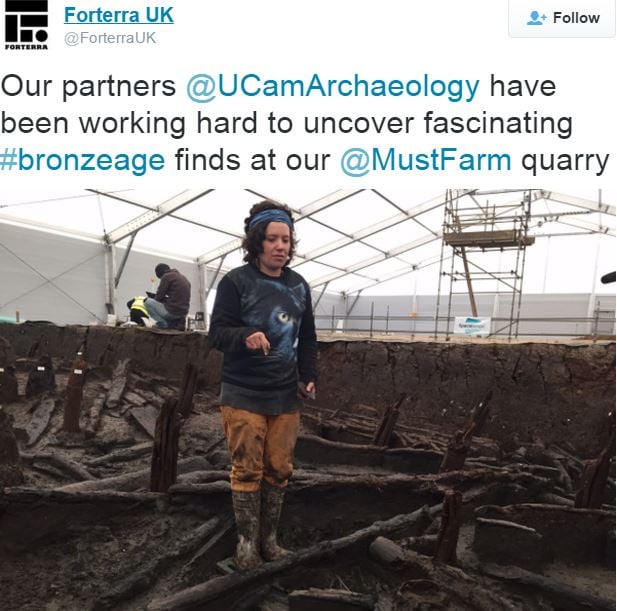 The charred remains of the Bronze Age dwellings are clearly visible. (Image: twitter.com/ForterraUK)
The charred remains of the Bronze Age dwellings are clearly visible. (Image: twitter.com/ForterraUK)
Historic England’s CEO, Duncan Wilson, explained:
“A dramatic fire 3,000 years ago combined with subsequent waterlogged preservation has left to us a frozen moment in time, which gives us a graphic picture of life in the Bronze Age. We are learning more about the food our ancestors ate, and the pottery they used to cook and serve it.”
“We can also get an idea of how different rooms were used. This site is of international significance and its excavation really will transform our understanding of the period.”
People rushed out of their homes
One can clearly see the well-preserved charred roof timbers of one of the roadhouses. The excavation site has a palisade (also called a stakewall or paling) – a perimeter of wooden posts that once enclosed the settlement.
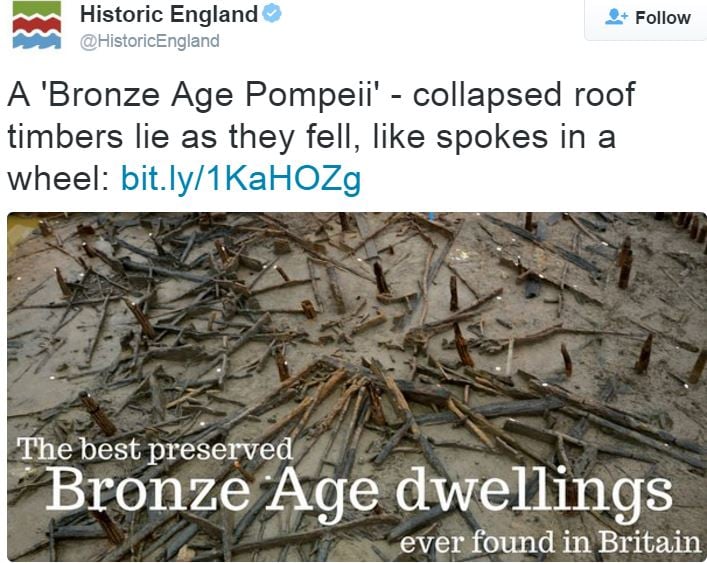 Comments keep pouring in to Historic England’s Twitter account, including “Amazing discovery – food in bowls for heaven’s sake!” and “The most fascinating thing I’ve seen/read in ages. Brilliant!” (Image: twitter.com/HistoricEngland)
Comments keep pouring in to Historic England’s Twitter account, including “Amazing discovery – food in bowls for heaven’s sake!” and “The most fascinating thing I’ve seen/read in ages. Brilliant!” (Image: twitter.com/HistoricEngland)
The archaeologists believe people left their homes in a hurry and had no time to take any of their possessions with them. Fortunately for us, everything is still in amazing condition thanks to the clay. Even footprints of the people who once lived there have been found.
Forensic archaeologists say they do not yet know what caused the fire that sent the dwellings to the bottom of the river. According to what they have found in the clay remains, we know how big the homes were and that they used 32 degrees of pitch for the roof.
More months of excavation still to go
What has been unearthed so far at the Must Farm site might be just the tip of a large archaeological iceberg, the researchers say. The excavation, which will continue for a number of months, is expected to unearth several more interesting items.
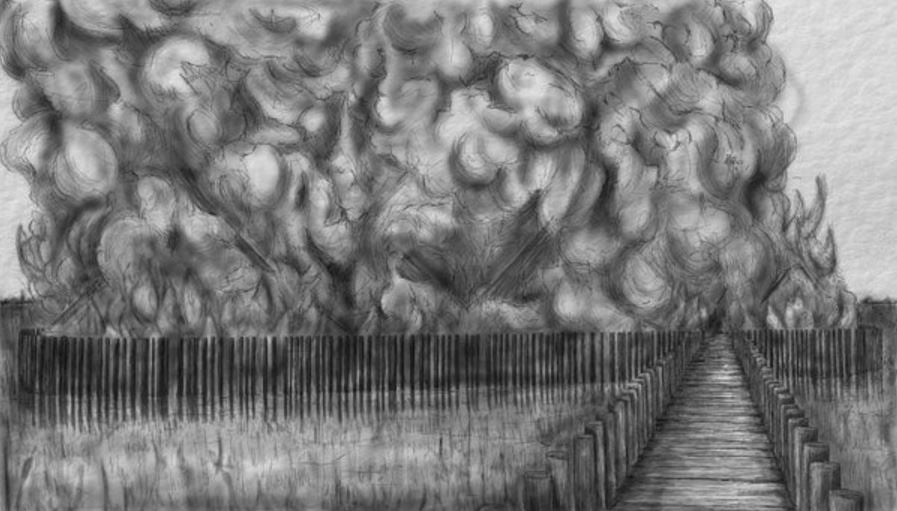 Artist Mike Hill’s impression of the fire that probably sent the dwellings to the bottom of the river. (Image: twitter.com/MustFarm)
Artist Mike Hill’s impression of the fire that probably sent the dwellings to the bottom of the river. (Image: twitter.com/MustFarm)
When the dig is completed, the archaeologists will take everything for further examination and conservation. The artefacts will eventually be displayed at the Peterborough Museum and other venues across East Anglia.
There will also be a major publication about the ancient Bronze Age settlement and an online resource with details of everything that was discovered.
The site is currently a quarry owned by Forterra Building Products Limited. It sits astride an ancient watercourse in the Flag Fen basin.
The site itself is two metres below the surface of the ground. The ground level is higher now than it was three thousand years ago. Members of the Cambridge Archaeological Unit say they have reached the riverbed as it was when people lived in the settlement all those thousands of years ago.
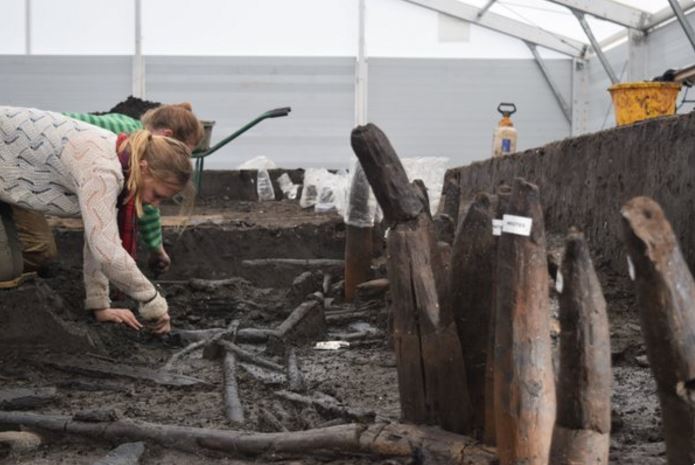 Remains of the pallisade that surrounded the settlement 3,000 years ago. (Image: twitter.com/MustFarm)
Remains of the pallisade that surrounded the settlement 3,000 years ago. (Image: twitter.com/MustFarm)
Archaeologists have found several Bronze Age items at the Must Farm site over the years. In 2011, nine pristinely preserved log boats were discovered, and a sword and rapier in 1969.
Must Farm excavation partners
The project is being funded by Forterra Building Products Limited and Historic England. The dig is being carried out by members of the Cambridge Archaeological Unit, who say they are about half-way through.
David Gibson, Archaeological Manager at the Cambridge Archaeological Unit, commented:
“Usually at a Later Bronze Age period site you get pits, post-holes and maybe one or two really exciting metal finds. Convincing people that such places were once thriving settlements takes some imagination.”
“But this time so much more has been preserved – we can actually see everyday life during the Bronze Age in the round. It’s prehistoric archaeology in 3D with an unsurpassed finds assemblage both in terms of range and quantity.”
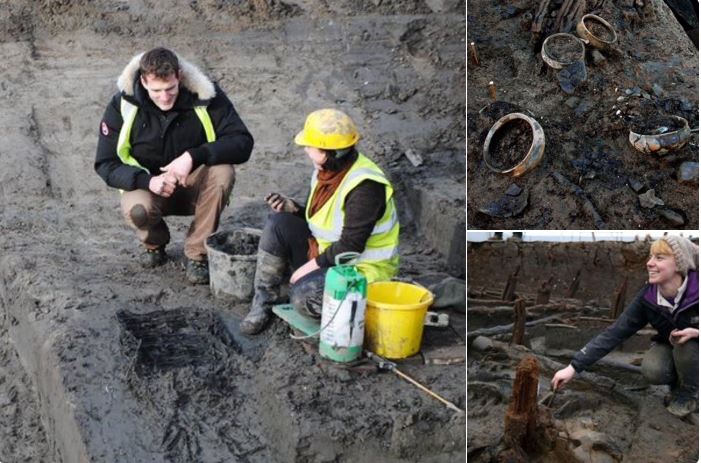 BBC history presenter Dan Snow talking to a member of the excavation team at the Must Farm site. (Image: twitter.com/History_Hit)
BBC history presenter Dan Snow talking to a member of the excavation team at the Must Farm site. (Image: twitter.com/History_Hit)
Mark Knight, Excavation Site Director, who believes the site provides a template of an ancient, undiscovered community, said:
“Must Farm is the first large-scale investigation of the deeply buried sediments of the fens and we uncover the perfectly preserved remains of prehistoric settlement.”
“Everything suggests the site is not a one-off but in fact presents a template of an undiscovered community that thrived 3,000 years ago ‘beneath’ Britain’s largest wetland.”
Brian Chapman, Head of Land and Mineral Resources at Forterra, said regarding his company’s participation:
“We’re delighted to be part of this incredible project which demonstrates our commitment to preserving the unique history of the site and look forward to working closely with our partners over the coming months and years.”
County Councillor Ian Bates, who is Chairman of the Environment and Economy Committee at Cambridgeshire County Council, said regarding this local legacy:
“We recognised early on the significance of the site and worked closely with partners to ensure the safe recovery of the archaeology found there. The Bronze Age finds really are of national prominence and it is important that it is preserved as a local legacy and for national audiences.”
Video – Bronze Age homes discovered at Must Farm site
Historian Dan Snow introduces the Must Farm site, where archaeologists have unearthed some incredibly well-preserved Bronze Age dwellings.

